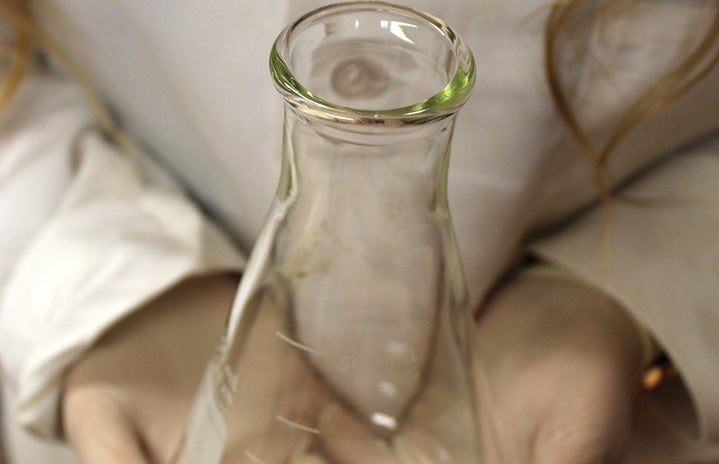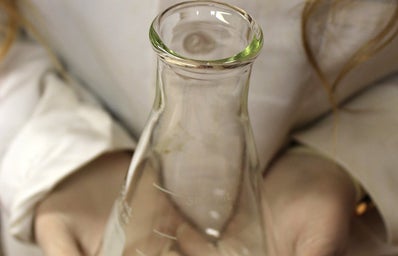Kristin Hofferberth is a chemistry teacher at Mount Vernon High School. She loves the process of chemistry, teaching, and her students! Her goal as a teacher is to help students understand critical concepts of chemistry so that they are best equipped for their next step. She got both her Bachelor’s Degree of Science in Chemistry and Master’s Degree in Secondary Science Education at the Ohio State University. While in her undergraduate program, she was especially interested in physical chemistry —investigating and understanding chemistry both qualitatively and mathematically. Kristin has previously taught physics at a different school and now teaches both chemistry and AP chemistry at Mount Vernon High School. She has also taught at Kenyon.
Yiyi: Hi Kristin! Thanks so much for agreeing to interview. What excites you so much about chemistry?
Kristin: I love that chemistry explains the “why’s” and “how’s.” Because for so many of the things around us, you see things happen —and then the chemistry explains why it happens and what’s going on. I love that! As a chemistry teacher, I also really like the fact that chemistry builds. We learn something, then we keep using it as we add and discover new things rather than having a whole bunch of discrete facts that you memorize then never use again. And I love the fact that I can basically roll my whole year. We’re constantly going back and learning more, adding to what we already know. And that —that’s just so satisfying —because it really shows how interconnected all the different aspects of what’s around us are.
Y: Cool! What are you guys learning right now?
K: So, in my AP class we are finishing up acid/base equilibrium, buffers and titrations… that’s always the hardest single unit in the entire year —there’s a lot of pieces that go into those titrations curves and understanding what’s going on during a titration. So that’s fun. In my first-year chem class, I just introduced the mole today. From here we’ll go from, you know, gram/mole conversions to actually doing stuff with the mole —calculating empirical formulas and really investigating what’s in a compound and how we know that.
Y: So what do you love most about teaching?
K: It’s the connection with the students that is probably the most meaningful. In terms of helping kids: one, discover that chemistry isn’t evil. I cannot tell you how many times I’ve been in the outside world, talking to people, and I say that I’m a chemistry teacher… more often than not, the response I get is, “Oh…that was a terrible course, I almost failed,” or, “it was horrible and I didn’t understand anything.” [Laughs.] And once in a while, I get someone who says, “Oh I had a great teacher! That was really fun!” But that’s definitely the minority of the time. So: one, helping students feel successful —providing the time and support. Building these relationships over the course of the school year… it’s really meaningful and I get to know these kids. That’s something that I really like about teaching high school versus when I was teaching briefly at Kenyon, before I went back full-time. You know, at Kenyon I would teach labs. I know it’s different for full-time faculty because I was just a visitor. I would see students for 3 hours, once a week, for a semester. And that was it! So I didn’t build those same relationships where I see my first-year kids for fifty minutes every day and I see my AP kids for close to 90 minutes every day. I really get a chance to work with them, see what they understand and where they are struggling and provide alternative methods to explain concepts to them. It’s a really fun process —seeing them recognize that for one, it is okay to struggle, that they can get past that, move on, and learn. They are still a smart and valuable person and but they can have that struggle. But then, just seeing them mature and bloom over the course of the year and building those relationships is really, really rewarding. And then I also really enjoy developing new materials —thinking, how do I get these new ideas across? It’s really fun.
Y: Do you have any suggestions about what we can do to make physical sciences more accessible to folks who have not had a lot of experiences in STEM?
K: I think, perhaps, talking about it, but talking about it in a way that doesn’t use all of the technical terms. Because that’s one thing that’s hard for people who are not in the sciences. As scientists in general, we have a familiarity with a set of vocabulary that is not in the common language. And so, when people talk about science, it’s wonderful for them to do it, especially if they can say things in a way that other people can connect with. So if they are excited about it, they can find out a little bit, but not in a way that makes them feel inferior. Not in a way that makes them feel like, “well I didn’t understand any of what you just said.” So, I think as science majors, being able to talk with general people in way that they can understand it as accessible, and then, you know, if there are opportunities to get involved with outreach programs, to take this science message of how cool it is, and how fun it is, and make it accessible and a positive experience for others, whether it’s at an elementary school or at a science center, or whatever. That’s another way that people can have an impact. In terms of making other young people—and even adults—see how cool science is, rather than it being this impenetrable wall.
Y: And my last question! Um… so, a couple months ago, I went to a physical chemistry conference in Michigan. I was just really blown away by how there weren’t many women there. It’s kind of like an image that is burned in my mind—because afterward, I just kept wondering why there weren’t more women present. It’s definitely not because women are worse than men in physical chemistry. So since then, I’ve been asking people about this question. Personally, it’s not an experience that I’ve ever had in physical chemistry. I talked to Professor John Hofferberth a while ago and he said that you had a similar experience in physical chemistry. So I wanted to ask you if you had any thoughts or insights concerning the lack of women in the field. And any suggestions for how to get young women into the physical sciences, to retain them, or what is even the problem?
K: I think there’s a lot here to unpack. I’m a little disheartened that your experience, 20 years after mine, was not that much different. I went to the [physical chemistry conference] in the year 2000 or so, and I don’t think there were any female faculty there and there were a handful of female graduate students. Some of that, I think, in that point in time, I can point to the fact that not too long before I was going through school, there was a very strong bias against women doing math and science.
Y: What do you mean “strong bias”? What does “strong bias” mean?
K: It was the assumption that girls couldn’t do math. If you talk to someone who went to school in the 60s, 70s, 80s, it was very much abnormal to see a woman in a hard science field. And the stereotype that girls are bad at math was still very much being perpetuated. And I kind of was hoping that I would see that less now. I was hoping that there would be a “trickle-up” effect happening, as more girls are going through and getting science degrees and staying in physical sciences. Some of it is probably a perception piece. Some of it might be an advertising problem, in terms of getting people more interested, and I think the best answer is catching girls’ interest earlier. Getting them engaged younger, getting in the advanced math classes younger, getting them in the advanced science classes younger. So that they can see that they are capable and take that to college, and hopefully graduate school. My only truly, overtly sexist experience was not with a physical chemist but in organic chemistry. I went in for office hours and he said, “You’re doing good for a girl!”
Y: Oh my god.
K: But that used to be a lot more common, which is why you would see a lot fewer women in science, at least the hard sciences. It was disinviting. I think that is changing, and I hope we see more of a trickle-up effect, but the biggest thing I can think of is getting more girls involved earlier. And things like ATHENA—the girls-in-science club for the middle school. Because when you pull girls into an all-girl situation, they don’t end up getting dominated by the guys. Some of that is just a difference in personality, some of that is a difference in societal expectation—like the way girls behave versus the way boys behave—but giving girls the chance to really excel in math and science fields earlier, I think, is the best way to fix that discrepancy. As well as, of course, making a productive effort to make the math and science fields more welcoming to women. That’s certainly the ongoing conversation right now, right? There’s certainly a whole bunch of stuff going on about eliminating sexual harassment at high profile institutions.
Y: For sure. Thanks so much for the food for thought, Kristin.
K: [Laughs.] No problem.
Let’s work together in paying attention to and encouraging the wonderful young women we have. The future is bright—we have so many thoughtful minds learning and developing ideas about both themselves and the future. Let’s give a thank you for all the ladies out there!!


